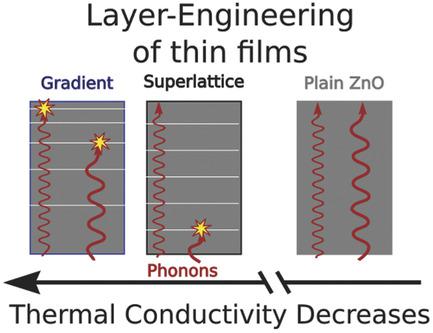当前位置:
X-MOL 学术
›
Adv. Mater. Interfaces
›
论文详情
Our official English website, www.x-mol.net, welcomes your feedback! (Note: you will need to create a separate account there.)
Thermal Conductivity Reduction at Inorganic–Organic Interfaces: From Regular Superlattices to Irregular Gradient Layer Sequences
Advanced Materials Interfaces ( IF 5.4 ) Pub Date : 2018-03-24 , DOI: 10.1002/admi.201701692 Fabian Krahl 1 , Ashutosh Giri 2 , John A. Tomko 2 , Tommi Tynell 1 , Patrick E. Hopkins 2, 3, 4 , Maarit Karppinen 1
Advanced Materials Interfaces ( IF 5.4 ) Pub Date : 2018-03-24 , DOI: 10.1002/admi.201701692 Fabian Krahl 1 , Ashutosh Giri 2 , John A. Tomko 2 , Tommi Tynell 1 , Patrick E. Hopkins 2, 3, 4 , Maarit Karppinen 1
Affiliation

|
Nanoscale superlattice structures are known to significantly suppress the thermal conductivity in thin films due to phonon scattering at the interfaces of the mutually different layers. Here it is demonstrated that in addition to the number of interfaces, their spacing within the film can lead to a reduction in thermal conductivity. The proof‐of‐concept data are for ZnO/benzene thin films fabricated through sequential gas‐surface reactions in atomic/molecular layer precision using the atomic/molecular layer deposition technique. In comparison to similarly constructed regular superlattice thin films, thermal conductivity values that are of the same magnitude, or even lower, are achieved for hybrid ZnO/benzene thin films in which the inorganic and organic layers are arranged in a more irregular manner to form various gradient patterns.
中文翻译:

无机-有机界面处的导热系数降低:从规则的超晶格到不规则的梯度层序列
众所周知,由于声子在相互不同的层的界面处散射,纳米级超晶格结构可显着抑制薄膜中的热导率。在此证明,除了界面的数量之外,它们在膜内的间隔还可以导致热导率的降低。概念验证数据是通过使用原子/分子层沉积技术以原子/分子层精度通过连续的气体表面反应制备的ZnO /苯薄膜的数据。与构造相似的规则超晶格薄膜相比,对于杂化的ZnO /苯薄膜,其热导率值具有相同甚至更低的值,其中无机和有机层以更不规则的方式排列以形成各种渐变图案。
更新日期:2018-03-24
中文翻译:

无机-有机界面处的导热系数降低:从规则的超晶格到不规则的梯度层序列
众所周知,由于声子在相互不同的层的界面处散射,纳米级超晶格结构可显着抑制薄膜中的热导率。在此证明,除了界面的数量之外,它们在膜内的间隔还可以导致热导率的降低。概念验证数据是通过使用原子/分子层沉积技术以原子/分子层精度通过连续的气体表面反应制备的ZnO /苯薄膜的数据。与构造相似的规则超晶格薄膜相比,对于杂化的ZnO /苯薄膜,其热导率值具有相同甚至更低的值,其中无机和有机层以更不规则的方式排列以形成各种渐变图案。



























 京公网安备 11010802027423号
京公网安备 11010802027423号